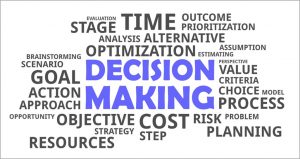How Optimization Moves Group Decisions Beyond Good and Better

In prior blogs, I have shared proven techniques and methodologies for improving group decision-making and have discussed opportunities to use those techniques and methodologies to solve complex problems such as formulating a budget, selecting investments, managing strategic alliances, and even reforming the U.S. immigration system. In all these examples, there exists a need to evaluate and prioritize a set of alternatives, which when done well, can represent a quantum leap forward for most organizations that struggle to build consensus and make great decisions. Today, just a few days before the 2018 INFORMS Conference on Business Analytics and Operations Research in Baltimore Maryland, I’d like to share how optimization can build on a good prioritization process and yield even greater benefit with very little extra effort.
What is Optimization?
 In the context of decision-making, optimization means determining the most favorable solution, outcome, or course of action from a set of alternatives that satisfies all constraints and dependencies. So, optimization is not about making a good decision or a better decision, but rather, making the best decision. Using commercially available mathematical programming solvers (i.e., optimizers), one can run an optimization scenario to examine and measure all feasible alternatives (often within seconds or minutes), to determine the most effective and efficient allocation of resources to solve a problem or achieve a goal. The benefits of a single, well-constructed “optimization run” can be significant – perhaps saving millions of dollars.
In the context of decision-making, optimization means determining the most favorable solution, outcome, or course of action from a set of alternatives that satisfies all constraints and dependencies. So, optimization is not about making a good decision or a better decision, but rather, making the best decision. Using commercially available mathematical programming solvers (i.e., optimizers), one can run an optimization scenario to examine and measure all feasible alternatives (often within seconds or minutes), to determine the most effective and efficient allocation of resources to solve a problem or achieve a goal. The benefits of a single, well-constructed “optimization run” can be significant – perhaps saving millions of dollars.
What Types of Problems Are We Talking About?
In our everyday lives, there is an almost infinite set of problems that can benefit from optimization techniques. Optimization typically includes a desire to maximize benefits of some kind, or to minimize costs or risks. To keep the list to a manageable level, here are some examples that we often encounter in the Washington D.C. metropolitan area, where there is a large presence of corporate headquarters, federal agencies, and technology service providers:
Corporate Finance
- Capital Budgeting – Selecting a combination of capital projects to maximize strategic benefit, return on investment (ROI), or net present value (NPV)
- Capacity Planning – Determining office locations, staffing levels, or work schedules to minimize costs, or maximize productivity and profitability
- Cost Reduction – Selecting a set of business requirements to maximize stakeholder preferences and best meet critical success factors
- Working Capital Management – Investing in certificates of deposit (CDs) with varying terms (1-month, 3-month, and 6-month) to maximize interest while meeting cash flow requirements
Acquisition, Partnering, and Purchasing
- Mergers & Acquisition – Identifying companies for merger and acquisition to maximize strategic alignment, cultural fit, or financial goals and targets
- Strategic Alliances – Select partners to maximize achievement of business goals. May include strategic marketing, branding and loyalty partnerships, or technology partnerships
- Source Selections – Awarding multiple contracts to suppliers who have bid different prices to supply various products and services to maximize competition or minimize risk in fulfilling acquisition requirements
Information Technology Services
- IT Demand Management – Screening ideas, evaluating concepts for alignment with the business strategy, and selecting projects to maximize benefit and the allocation of resources
- Risk Assessments – Conducting operational, technology, supplier risk assessments, and selecting mitigation plans, contingency plans, and remediation actions to minimize risk exposure
- Security Assessments – Conducting cybersecurity assessments and selecting remediation actions to maximize compliance
- System Development – Selecting a set of business requirements to best meet critical success factors and maximize stakeholder buy-in
 How Can We Optimize?
How Can We Optimize?
You may be wondering how your organization can obtain an optimization capability, and more specifically, do you need a PhD in operations research? Thankfully no. There are decision support solutions in the market, such as our Definitive Pro™, that have embedded optimizers, such as Gurobi, lp_solve, or COIN-OR. Using a decision support solution will not only enable the fast adoption of the best practices associated with prioritization, but it will also provide a simple and structured technique to perform optimization. Once your organization is doing optimization, you will no longer need to settle for making a good decision or a better decision, as you will be able confidently make the best decision.
© 2018 Definitive Business Solutions. All Rights Reserved.
John Sammarco has thirty-five years of experience leading, managing, and consulting to top public and private sector organizations, and has over twenty years of experience in facilitating complex group decisions. John founded Definitive Business Solutions in 2003, which provides world-class group decision-making solutions to increase efficiency, boost ROI, and reduce risk associated with business and technology investments. In 2016, John developed Definitive Pro™, which helps groups build consensus and make multi-criteria decisions.
